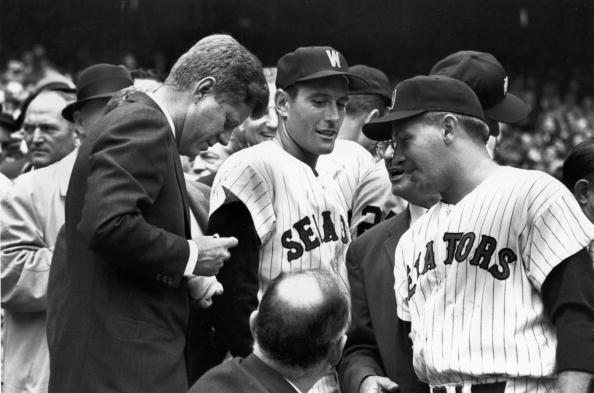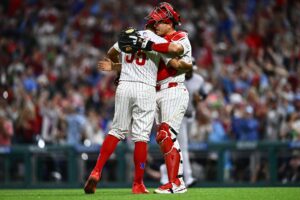For the next in our list of courageous comebacks, we shift back in the proverbial vault. True, 1961 may not be the absolute bastion of “back there,” but it’s still pretty far back. So far, in fact, that it was during the second incarnation of the old Washington baseball team. This version of the Washington Senators never did a lot during their time in the Nation’s Capital. However, that doesn’t mean that they are completely devoid of interesting stories. This, in truth, might be one that fans of the current Texas Rangers might want to forget about. They are not the subjects, but rather the recipients of a rather brutal ninth-inning comeback. It also happened during the first year of the franchise, which is something else that’s not easily remembered. We’ll discuss this further in a moment.
June 18, 1961: Washington Senators vs. Boston Red Sox
First, let’s examine the uniqueness of this game among comebacks. The truth is that this is a tale of multiple comebacks in one contest. If one Major League game were ever to be filed under the category of “roller coaster,” it would be this one. It matches our last story in that it happened in the first game of a doubleheader. However, unlike the previous installment, this is not the story of one team’s rousing determination. No, this is a story of two teams trying their absolute best to both somehow win and lose at the same time. Some of the stories within this are so extensive, that this entry will be split into two parts. So, with that said, let’s begin.
The 1961 Washington Senators
As stated previously, the 1961 Senators were a team fresh on the scene. General Manager Edward Doherty and Manager Mickey Vernon looked to steer the young franchise through its first season. However, this was much easier said than done. A drastically bad offense combined with mediocre pitching helped the team finish ninth in the American League. That said, they weren’t completely sunk when it came to certain elements. Catcher Gene Green put up more than respectable numbers (.280/.341/.489, 18 HR, 125 OPS+). Right fielder Gene Woodling led the team in average (.313) and OPS+ (140). Finally, third baseman Danny O’Connell led the team in hits (128) and doubles (30). Aside from these three, the rest combined to produce a lackluster offensive showing.
Then, there was the pitching. A staff ERA of 4.23 and an ERA+ of 93 speak to their performance. Rookie “ace” Joe McClain lost 18 of his 29 starts. However, the surprise of the rotation came in the form of 10-year veteran Dick Donovan. He’d been an All-Star with the Chicago White Sox in 1955 and even finished second in Cy Young Award voting in 1957. Then, he’d taken a nosedive. Despite posting a 6-1 record with Chicago in 1960, his ERA of 5.38 was far from pretty. Washington must have seen something in him, for they took him with the 54th pick in the expansion draft. Fortunately, they guessed correctly. He wound up leading the league in ERA (2.40), ERA+ (163), and WHIP (1.026) in 1961. He also made his second All-Star appearance. Other than that, the rotation was mediocre to good and the bullpen was one of the worst in baseball.
The 1961 Boston Red Sox
We shift gears now to their opponents, the 1961 Boston Red Sox. Much like the Senators, this was a team in the midst of a struggle. The franchise, as a whole, were strangers to postseason play. From 1946 to 1967, they would not come close to winning a pennant. 1961 would be no different. Nevertheless, they were introduced to someone who would help them out of the drought in years to come. Namely, the future Hall of Famer Carl Yastrzemski. Despite not putting up stellar rookie numbers, he’d come into his own during his second year. Other than this, 1961 was not a very noteworthy year for Beantown’s favorite team. They’d finish sixth in the American League with a 76-86 record.
The offense was mired in a purgatory of mediocrity. They hung around the middle of the league in a lot of categories. First baseman Pete Runnels had a productive season (.317 avg, 117 OPS+) and outfielder Gary Geiger led the team with 18 home runs. Second baseman Chuck Schilling led the team in hits (167) but had a horrific 79 OPS+. This was something of a microcosm for the entire offense. One thing they did do well was show patience at the plate. They ranked third in the league in walks and on-base percentage. However, they also struck out at a clip slightly above league average. So, once again, we find mediocrity where we should be looking for solid production.
A Suspect Pitching Staff: The Key to Comebacks
On the mound, these Red Sox were far from brilliant. A 4.29 ERA ranked eighth in the league. The team’s ERA+ (97) and FIP (4.37) numbers suggest that they might have actually gotten lucky a couple of times. The rotation was a mixed bag, with ace Bill Monbouquette posting an even 14-14 record and an ERA of 3.39. Third in the rotation was Don Schwall, who won 15 games with an ERA of 3.22. It sounds impressive, but his FIP of 4.09 speaks to the amount of luck tossed his way. He also had a WHIP of 1.550, thus cementing this theory. The other two pitchers in the rotation combined to go 17-23 and both had ERA+ numbers of 85.
Bullpen-wise, again, it was an odd cocktail of results. There were extremely poor performances from setup man Tracy Stallard (2-7, 4.88 ERA, 85 ERA+, 1.553 WHIP) and Billy Muffett (3-11, 5.67 ERA, 73 ERA+). They had a lot of experience at the back end of the bullpen, entrusting it to veteran pitcher Mike Fornieles. This was not without reason, as he had posted a 2.64 ERA the previous season. However, when one realizes that he had a concerning 65% save percentage, it causes one to question the Red Sox’s decision here. However, they went with it. He did manage to improve his save percentage, however, he still blew five of his 20 opportunities.
Where Comebacks Meet Cliffhangers
Thus, the groundwork’s laid for this story. Comebacks are rich in their backgrounds, and this one is no exception. Cliffhangers might be considered cliché by many, but here, it is needed. The extensive seasons of both of these teams practically beg to be understood before progressing to the game itself. True, there are some stories of comebacks where they’re rather form-fitting. This is not one of them. So, consider this the appetizer before the main course. Next week, we’ll discuss the contest in full.
Main Photo:
Embed from Getty Images
Players Mentioned:
Gene Green, Gene Woodling, Joe McClain, Dick Donovan, Carl Yastrzemski, Pete Runnels, Gary Geiger, Chuck Schilling, Bill Monbouquette, Don Schwall, Tracy Stallard, Billy Muffett, Mike Fornieles






